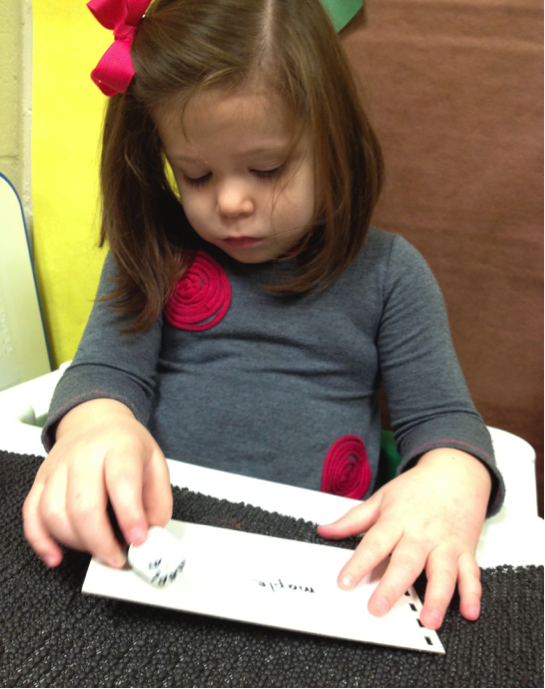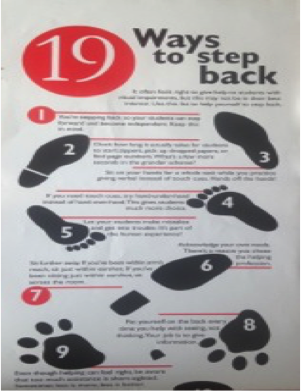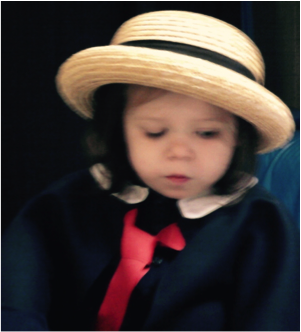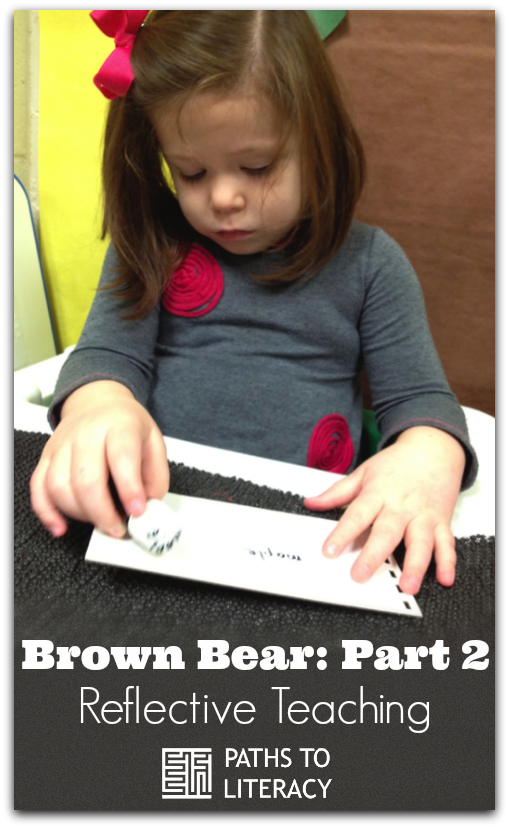Brown Bear Part II: Reflective Teaching
Submitted by Laurie Hudson on Dec 01, 2015
 In Brown Bear Part I, posted earlier on Paths to Literacy, I used a short video of a teaching segment to demonstrate what the concepts in my iBook, “Introducing Braille,” might look like for a struggling reader with multiple impairments. How might, “Make It Fun,” “Make it Developmental,” and “Make It Meaningful” translate to these young braille readers? I explored this as I taught Alison, an 8-year-old girl with total blindness, a hearing loss in one ear, low tone, a heart defect, slowed physical growth, and a significant developmental delay. She understands some spoken words and phrases; she does not talk or use a communication device but she uses five or six signs upon request.
In Brown Bear Part I, posted earlier on Paths to Literacy, I used a short video of a teaching segment to demonstrate what the concepts in my iBook, “Introducing Braille,” might look like for a struggling reader with multiple impairments. How might, “Make It Fun,” “Make it Developmental,” and “Make It Meaningful” translate to these young braille readers? I explored this as I taught Alison, an 8-year-old girl with total blindness, a hearing loss in one ear, low tone, a heart defect, slowed physical growth, and a significant developmental delay. She understands some spoken words and phrases; she does not talk or use a communication device but she uses five or six signs upon request.Focus of My Reflection
“Good teaching is not about sticking to the script,” says Professor Andrew Pollard. “It’s about continually reflecting on your pupils’ changing needs and the ways in which you meet them...” At the end of Brown Bear Part I, I commented on how my repeated study of my 57 second video lesson segment allowed me to reflect on my own teaching. This brings me to Brown Bear Part II, a discussion of this reflective teaching.
Watch (or rewatch) the video below:

My specific focus in this reflective teaching is how much independence I allowed Alison. I’ve given prompting/cueing a great deal of thought over the years, even publishing “19 Ways to Step Back” in “Classroom Collaboration” through Perkins and later as a poster through the American Foundation for the Blind. Especially as the author of “19 Ways to Step Back,” was I minimizing my cues and prompts with my student Alison as much as possible? (Prompts provide general encouragement. A teacher’s hand on a student’s shoulder might be a prompt to keep attending; the phrase,“ do another one” might serve as a verbal prompt. Cues are specific guidance of how to do the task. A physical cue might be hand-under-wrist touch guiding the student to press brailler keys; a verbal cue might be saying, “Press the keys to write another letter.”)
How Alison Learns
At the time of this filming, I had taught Alison as both her TVI and her O&M instructor for three years. I had a clear sense of how she learned.
- She liked candy, music, standing up, spinning and swinging, sucking her thumb, pressing her eye, hugs, flapping paper, and alone time.
- Her only preference on the above list that had served as a powerful positive motivator was candy; that is, we (her IEP team) saw increases in her behavior when it was followed by candy, but not by her other known preferences. Not surprisingly, candy was not a viable option for her because it was unhealthy (especially related to Alison’s slowed physical growth,) it was extrinsic, it was not sustainable, and it was against school policy and home policy ….. and my own professional policy.
- We had not yet seen Alison respond to a token economy.
- Waiting for Alison to respond had not been successful, since alone time was one of her preferences. Beyond that, Alison seemed to forget what was asked of her after 5 or 10 seconds of wait time.
- We had been successful in shaping Alison’s behavior through routine. She tended to participate most when she was engaged in a familiar activity. For example, after she had learned a chain of step 1, to step 2, to step 3, she tended to maintain momentum throughout it.
- Once Alison was engaged in a chain of steps, she sometimes showed curiosity in what she was doing.
My Cues and Prompts in this Lesson Segment
In viewing and reviewing the videotape, I identified the prompts and cues I included. My physical prompts were: hand-under-hand, hand-under-wrist, hand-over-hand and hand-under-arm. Verbal prompts were instructions to turn each page, tapping into Alison’s prior knowledge (“You know ‘p,’ that’s one of your letters,”) and asking Alison to continue a behavior (“Write some more.”)
Ways I Stepped Back in this Lesson Segment
I identified seven ways in which I encouraged Alison to work independently. (1) I included wait times of a few seconds before repeating prompts, and (2) I used physical guidance so slight that Alison could (and did) easily withdraw her hand. (In fact, there were 4 or 5 aborted videotaped segments in this same session where Alison unequivocally refused to read or write.) (3) I started with verbal cues, adding physical cues only as they seemed necessary for Alison to maintain momentum. My physical cues were proximal (closer to the center of her body) rather than distal (closer to her fingertips) where possible. (4) I specifically and enthusiastically praised Alison when she showed initiative in pressing brailler keys. “You’re writing some more letters while you’re at it.” (5) I asked Alison to continue the desired behavior of pressing keys after she already started this. “Write some more letters. (6) I used shaping/accepting approximations (such as accepting Alison’s turning 2 pages at a time instead of one, and allowing her to read and sometimes write with just one hand.) (7) I allowed short breaks after a non-preferred activity, then returning to it.
Reflection
I’m happy that I was able to provide meaning by teaching at Alison’s home with her mother present, and by using text that Alison had been enjoying both at home and school. Self-reflecting through videos keeps us honest, though. I stepped back in a range of ways, but I wonder if I could have stepped back even more in this instance. I wonder, if I had provided fewer or less restrictive prompts/cues, what other strategies I could have used to establish and maintain Alison’s focus.

Yes …… but. I had four rationals for my prompting/cueing. (1) Alison’s mother did so much to help her to love reading, including making her a costume for the story book character “Madeline” at Halloween. But she had become discouraged about Alison’s writing at home, and I was eager to show her how she is writing with me at school. But was I too eager, resulting in my hurrying Alison? (2) My physical guidance was so slight that Alison could … and did …. withdraw her hands at any time. But was she ready for less guidance? (3) I had long since found that maintaining pacing/momentum in lessons was key for this student, but did I allow too little wait time? (4) Sometimes Alison’s curiosity seemed to overcome her protests if I could just get her initial involvement. But was there another way to accomplish this?
We have such a wealth of knowledge and experience in our Paths community. I feel vulnerable in posting this reflection, but your comments and suggestions around it would be very helpful to me, and I hopefully to each other. Have you used videotaped lessons in your own reflective teaching? What did you notice in this posted video with Alison? What’s your take on this? What might I have done next in terms of establishing and maintaining Alison’s time on task? How else might I have engaged her? Thanks much.


Comments
Stepping back
Laurie, first I’d like to
Makes me wonder….
Reflective Teaching
Loved this post!
Our Paths community rocks!!
Reflective Teaching
Hi Laurie, Thank you for
Reading Feedback is Unique Learning Experience!
Reflective practice, a new level
Sitting right next to Alison and me in our little work room